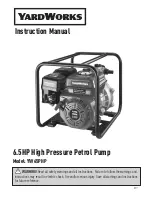
6
wood carving, and fragile model parts.
Higher speeds are better for carving, cutting, and shaping
wood. Hardwoods, metals, and glass require high speed
operation. Drilling should also be done at high speeds.
To determine the optimum operational speed for different
materials and accessories, refer to the speed dial settings
table.
The best way to determine the correct speed for work on
any material is to practice for a few minutes on a piece of
scrap, even after referring to the table. You can quickly
learn whether a slower or faster speed is more effective
just by observing what happens when you make a pass or
two at different speeds.
When working with a scrap piece of plastic, start from
a slow rate of speed and increase the speed until you
observe the plastic is melting at the point of contact;
reduce the speed slightly to get optimum working speed
without melting the workpiece.
NOTE:
Plastic and materials that could melt at slow
temperatures should be cut at low speeds.
Soft wood should be cut at high speed.
Aluminum, tin, copper, lead, and zinc alloys may be
cut at any speed, depending on the type of cutting
being done. Use paraffin or other suitable lubricant on
the cutter to prevent the cut material from adhering to
the cutter teeth.
For more information, see table on speed dial settings.
OPERATING THE ROTARY TOOL
See Figure 10.
Learning to use the rotary tool:
Hold the tool in your hand and get used to its weight,
balance, and the taper of the housing. This taper
permits the tool to be grasped like a pencil.
Examine the rotary tool accessories carefully.
Damaged accessories can fly apart as they come up
to speed and should not be used. The use of damaged
accessories can result in serious personal injury.
Practice on scrap materials first to see how the tool
operates. Keep in mind that the work is done by the
speed of the tool and by the accessory in the collet.
You should not lean on or push the tool into the work.
It is best to make a series of passes with the tool rather
than attempt to do all the work in one pass. To make a
cut, pass the tool back and forth over the work like you
would a small paint brush. Cut a little material on each
pass until you reach the desired depth. For most work, a
gentle touch is best; you will have greater control, make
fewer errors, and get the most effi cient work out of the
accessory.
For the best control in close work, grip the tool like a pencil
between your thumb and forefi nger. A “hand grip” method
of holding the tool is used for operations such as grinding
a fl at surface or using cut-off discs.
To operate the rotary tool:
Secure all work in a vise or clamp to a workbench to
prevent it from moving under the tool.
Hold the tool in front and away from you, keeping the
tool accessory clear of the workpiece.
Turn on the tool and let the motor and accessory build
up to full speed.
Lower the tool gradually until the accessory contacts
the workpiece.
Move the tool continuously at a steady, consistent
pace.
Use just enough pressure to keep the tool from
chattering or bouncing.
NOTE:
Heavy pressure will decrease the tool’s speed and
put a strain on the motor. The weight of the tool alone is
adequate for most jobs.
Lift the tool away from the workpiece before turning
off the tool.
TELESCOPING TOOL HANGER WITH CLAMP ON
BASE
See Figure 11.
The telescoping tool hanger provides a convenient place
to hang the rotary tool while the fl ex shaft is in use.
To clamp the base to a worktable:
Turn the clamp screw counterclockwise to open the
clamping area.
Place clamp over the edge of worktable.
Turn the clamp screw clockwise until the clamp is
secure.
To attach the tool hanger to the base:
Turn the lower part of the tool hanger clockwise to
unlock.
Pull the tool hanger up to lengthen or push the tool
hanger down to shorten its height.
Turn the lower part of the tool hanger counterclockwise
to lock into place.
Screw the tool hanger into the top of the clamp.
NOTE:
When using the fl ex shaft, hang the rotary tool on
the tool hanger hook using the hook located at the back
of the rotary tool.
OPERATING THE FLEX SHAFT
See Figures 12 - 14.
The 1/8 in. collet must be inserted into the rotary tool
before the fl ex shaft can be installed. To install the fl ex
shaft:
Unplug the rotary tool.
Loosen collet sleeve by turning counterclockwise, then
remove.
Press and hold the spindle lock, and rotate the shaft
by hand until the spindle lock engages the shaft,


































